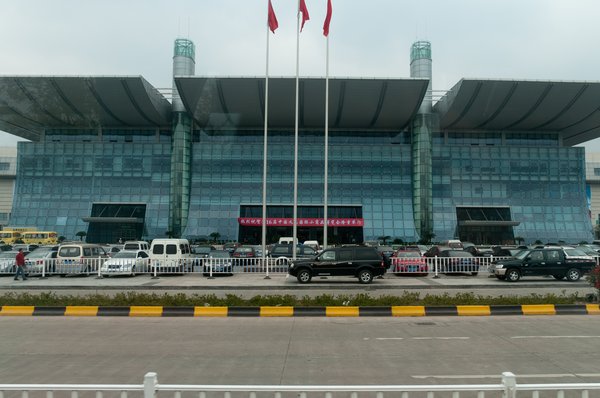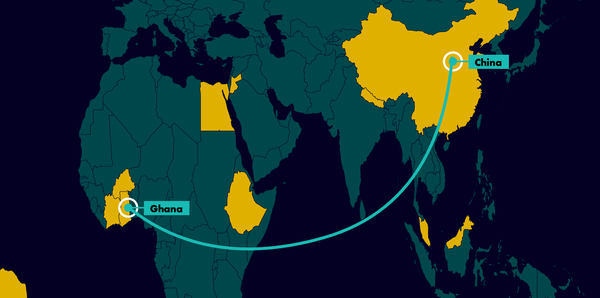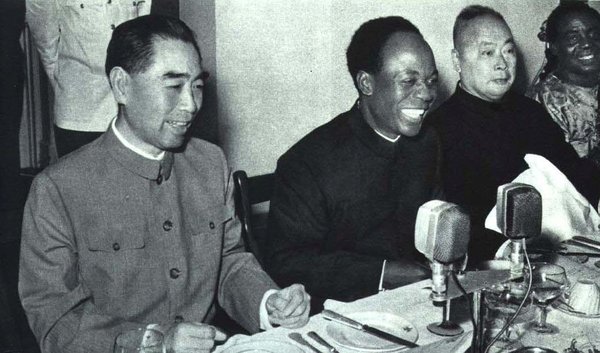
An intermediary agency in the local village of Shanglin. Photo by Dongsheng Wang. CC BY-NC 4.0
The history of Shanglin people's gold rush in Africa
Shanglin County is in Nanning City, Guangxi Province. Gold deposits are distributed in three towns of this county, thus leading to a tradition of gold mining. In June 2006, the first group of Shanglin people began to go to Ghana, known as the Gold Coast, for gold mining. These gold miners do not choose to settle in Ghana for a long time but are more likely to go home every one to two years to rest for about three months before returning. Most of these gold miners made huge profits, which in turn encouraged many gold miners to migrate to Ghana for the purpose of mining. Their numbers exceeded 12,000 before 2013. Our MIDEQ team conducted field research, at the end of 2020, with local miners, their families and leaders of the Shanglin Gold Miners Associate in Shanglin County. We found that at that time, almost all the families in the three townships in Shanglin County had male members involved.
After the new Ghanaian government came to power and launched a crackdown on illegal mining in 2013, a large number of Shanglin people chose to abandon their investment in Ghana and return home. There were also gold miners who chose to hide deep in the mountains with equipment, waiting for a chance to start work again. Others chose to go to other countries in Africa to open new mines. However, the number of Shanglin miners in Ghana has declined sharply since 2013. Since then, the overall number has remained at about 30,000 and the distribution of gold miners has also expanded to countries such as Mali, Togo, and Congo. In 2020, as a result of the COVID-19 pandemic, many gold miners who returned home before the Spring Festival couldn’t return to Africa after the festival. According to the information given to us by the Secretary General of Gold Miners Association, at present, the number of Shanglin miners in Africa is about 10,000.
The social network of Shanglin miners
Such large-scale migration depends on the existence and support of a large social network. Inside the gold mine, the bosses are the owners of gold mining equipment and mines. They not only need to pay wages and bonuses to the workers, but also need to meet the daily expenses of the entire workforce. Workers from Shanglin are employed by these bosses to play the role of foreman or technician in the mine. There are also many African workers from local communities who undertake most of the daily work in the mine. The land occupied by mining generally comes from the local community, which is purchased by the boss from the chief or landlord in the community. These local elites generally have cooperative relations with miners. In addition to providing land, they sometimes provide assistance in obtaining mining permits. In return, they not only receive land rent but also receive a certain percentage of dividends from the mining revenue. More broadly, in Africa there are many businessmen who are closely related to these gold miners, who are engaged in various industries such as supply of mining equipment, gold acquisition, medical care, translation and intermediation. Although they are not directly involved in mining activities, the various services they provide ensure that Shanglin gold miners can live and work locally for a long time.
Mine owners and Shanglin workers are important nodes of these networks, and their continuous migration is the basis for maintaining the existence of the entire network. Within the gold miners, the identities of bosses and workers are not fixed. If a worker accumulates a certain amount of capital, he will try to become the boss and start running his own mine. If the boss loses most of his assets because of investment failure, he will choose to work for other bosses, thus accumulating enough money to repay debts and make new investments. Withdrawing from mining activities is not a common choice, and the social network of gold miners in Shanglin plays a key role in this process.
Economic problems do not pose an obstacle for Shanglin people who are willing to go abroad for gold mining. Through our interviews, we learned that the bosses would pay all the expenses for their employees to go abroad and, in exchange, the workers need to promise to work for the boss for about one year. In the meantime, workers can also choose to change bosses at the cost of returning air tickets and visa fees paid for them by their old bosses. Repayment is mostly borne by their new bosses. Under this mechanism, even those who owe huge debts due to the failure of mining investment have the opportunity to go abroad again. Thus, the social network of these migrants functions as a way to mitigate risk.
What maintains the unity of gold miners is a generalised trust relationship based on the identity of the "Shanglin people". For these miners, "Shanglin people" mean both the ability to mine gold and the qualities that can be trusted. This identity greatly expands the scope of the social network of gold miners, enabling gold miners to find working partners and opportunities outside the range of their relatives and friends. For most gold miners, the high income and long-term accumulated contact make them willing to take gold mining as a long-term livelihood strategy. Therefore, from the two aspects of individual will and external conditions, the existence of migration network lays the foundation for the sustainability of long-term migration from China to Ghana.



